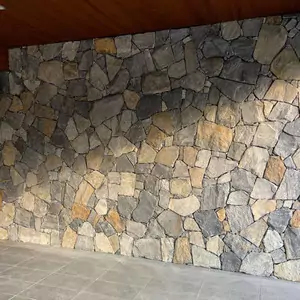We feel as though we have returned to the Stone Age.
You heard us correctly!
Not at a primitive period, of course, but in the advanced stone period. Yes, we ate talking about stone wall cladding.
What is it exactly?
Well, it is the application of a thin veneer of stone to a non-stone building or other structure. Natural stone wall cladding can therefore be applied to bricks, concrete walls and other structures. The fact that each stone piece’s back is sawn to a flat mesh that is simple to place onto the proper substrates simplifies this operation.
Thin slices of naturally occurring stones that have been quarried worldwide are used to make natural stone cladding. The stones are cut into blocks and boulders after being removed from the ground. After that, these are produced and processed to create the goods you buy.
Now, there are two types which are popular opted for: Stacked Stone and Dry Stone Wall Cladding. This blog gets into the details of each type to let you make an informed choice.
What is Dry Stone Wall Cladding?
Dry stone walls are durable and long-lasting since they don’t require mortar. They are held in place by the weight of the stones. The strength and durability of the stones are determined by how they are stacked. Professionals and experts build beautiful dry stone walls.
There are a number of amazing examples of dry stone walls that are thousands of years old and still standing. Some people believe that this type of stone wall is better than a mortar wall. Dry stone walls are permeable to water. On the other hand, mortared walls promote moisture. The advantages of dry stone walling are numerous.
Pros & Cons of Dry Stone Wall Cladding
- Pros:
- Durability: Properly constructed dry stone walls can last for many centuries.
- Flexibility: They don’t break when the ground shifts because of their extraordinary flexibility.
- Aesthetics: They have a timeless, organic appearance and blend in well with the surroundings.
- Environmental Benefits: They allow water to drain and provide habitats for small animals.
- Cons:
- Labor-intensive: Building a dry stone wall requires a lot of skill and labor and is a costly and time-consuming procedure.
- Limited Availability: It might not always be possible to locate suitable stones nearby.
- Maintenance: Even though they are long-lasting, they may require occasional maintenance to correct loose stones or settling.
- Structural Restrictions: Not all types of constructions can use them, especially ones that must be able to bear a significant weight.
What is Stacked Stone Wall Cladding?
Small, discrete pieces of natural stone make up stacked stones, which are ready-to-use stone veneers. Stacked stones can effortlessly turn any wall or column into a striking element. When you don’t have the time or resources to piece stones together one at a time, stacked stone panels are perfect for adding visual appeal to your exterior or interior walls or other vertical constructions. When installed, the panels’ stacking and glueing create a realistic three-dimensional effect on your wall. It looks like a building you may see in an old city or outside.
Pros & Cons of Stacked Stone Wall Cladding
- Pros:
- Durability: When built correctly, stacked stone walls may withstand weather and the passage of time for decades.
- Versatility: They can be used for both indoor and outdoor décor, as well as for retaining walls and garden borders.
- Eco-Friendly: Because stacked stones are made of natural materials and are frequently purchased locally, they are a sustainable choice that lowers carbon emissions.
- Low Maintenance: After construction, stacked stone walls typically require little maintenance, in contrast to some other materials.
- Cons:
- Expensive Installation: Building stacked stone walls is a labor-intensive process that calls for expert workmanship, which can raise the cost.
- Stone Availability: Depending on the area, access to the appropriate kind and amount of stones may be restricted.
- Unsuitable for Heavy Loads: Stacked stone walls aren’t always appropriate for applications requiring a lot of weight or force.
- Stone Shifting Susceptibility: Over time, stones may move as a result of soil movement or severe weather, requiring sporadic repairs.
- Time-consuming: In comparison to other construction techniques, building a stacked stone wall requires a significant amount of time.
The Bottom Line
Both stacked stone wall cladding and dry stone wall cladding have certain advantages that make them classic and adaptable options for improving your areas. Particularly in regions subject to earth movement, dry stone wall cladding is notable for its traditional craftsmanship, inherent durability and flexibility. However, stacked stone cladding offers a sleek, contemporary appearance with pre-assembled panels that make installation easy and produce breathtaking visual effects.
The requirements of your project will determine which option is best for you. Dry stone cladding is the best option for a genuine, rustic charm and environmentally beneficial drainage. Stacked stone wall cladding is the best option if you want easy installation, modern design and adaptability for both indoor and outdoor environments.
Whichever style you decide on when it comes to stone wall cladding in Sydney, your walls will be transformed into eye-catching design features with long-lasting sturdiness and environmentally friendly appeal.
